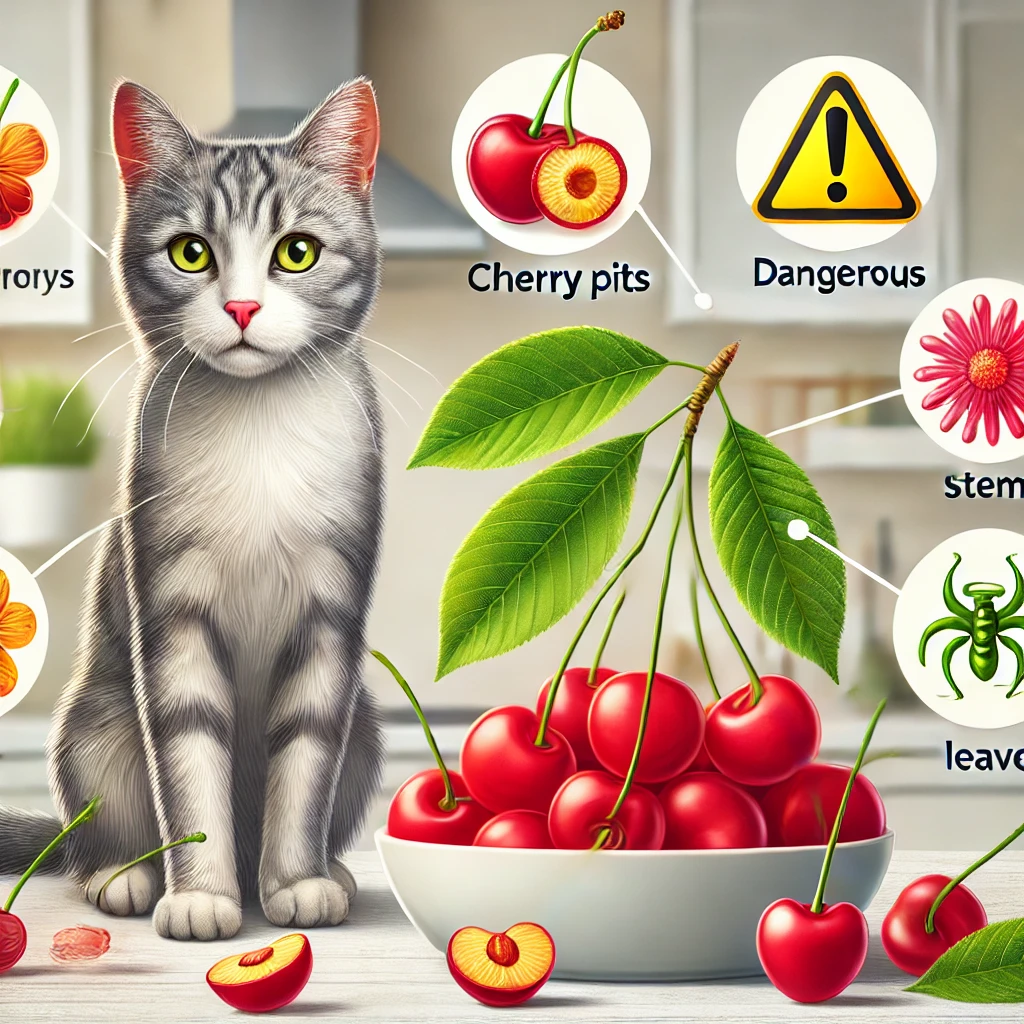
Can Cats Eat Cherries? Everything You Need to Know
Cherries are a popular and nutritious fruit for humans, packed with antioxidants, vitamins, and minerals. However, when it comes to cats, the answer is not so straightforward. Cats are obligate carnivores, meaning their primary dietary needs revolve around meat. While cherries are not inherently toxic to cats, certain parts of the cherry plant can pose significant risks.
Table of Contents
The cherry pit, stems, and leaves contain cyanogenic glycosides, a compound that can release cyanide when digested. Cyanide is highly toxic and can lead to symptoms like difficulty breathing, dilated pupils, and even death in severe cases. Even the flesh of the cherry, while not toxic, contains sugars that may upset your cat’s digestive system.
It’s essential to understand that cats have different nutritional requirements from humans. Foods that are harmless or even beneficial for us may not be suitable for our feline friends. In the case of cherries, the risks often outweigh the potential benefits.

What Parts of a Cherry Are Dangerous for Cats?
Cherry Pits
The pits of cherries are the most dangerous part for cats. They contain amygdalin, a cyanide-producing compound that can cause cyanide poisoning. Swallowing a cherry pit can also pose a choking hazard or lead to intestinal blockages, especially in smaller cats.
Cherry Stems and Leaves
The stems and leaves of cherry plants also contain cyanogenic glycosides. While cats are less likely to consume these parts, accidental ingestion can occur, particularly if they’re curious or playful. Symptoms of cyanide poisoning include difficulty breathing, vomiting, and a rapid heart rate.
Cherry Flesh
The flesh of cherries does not contain cyanide but is still not ideal for cats. The high sugar content can lead to gastrointestinal upset, obesity, or even diabetes in the long term. Even a small amount can cause issues for cats with sensitive stomachs.

What Happens if a Cat Eats a Cherry?
Mild Symptoms
If your cat consumes a small amount of cherry flesh, the symptoms are likely to be mild. These may include stomach upset, vomiting, or diarrhea. Monitoring your cat closely is crucial, and providing plenty of fresh water can help flush out the sugar from their system.
Severe Symptoms
Ingesting cherry pits, stems, or leaves can lead to severe symptoms of cyanide poisoning. These include:
- Rapid or labored breathing
- Bright red gums
- Seizures
- Collapse
If you notice any of these symptoms, contact your veterinarian immediately. Time is critical in cases of poisoning, and professional treatment may involve activated charcoal, intravenous fluids, or other interventions.
Can Cats Benefit from Cherries?
While cherries are rich in antioxidants and vitamins for humans, these benefits do not translate to cats. Cats lack the enzymes needed to break down certain plant compounds, rendering many of the nutrients in cherries inaccessible to them. Instead of cherries, stick to cat-safe fruits like blueberries or apples (without seeds) if you wish to offer your cat a fruity treat.
How to Keep Cats Safe Around Cherries
Store Cherries Safely
Always keep cherries and other potentially harmful foods out of your cat’s reach. Store them in sealed containers or the refrigerator to prevent accidental ingestion.
Educate Family Members
Ensure everyone in your household knows the risks cherries pose to cats. This is especially important for children who may unintentionally share their snacks with pets.

Provide Alternative Treats
Offer your cat safe and nutritious treats instead. Many pet stores sell cat-specific snacks that cater to their dietary needs.
Q&A About Cats and Cherries
Q: My cat ate a small piece of cherry. Should I be worried? A: If it was just the flesh and a small amount, monitor your cat for signs of digestive upset like vomiting or diarrhea. If they consumed the pit, stem, or leaves, contact your veterinarian immediately.
Q: Can cats eat dried cherries? A: Dried cherries are high in sugar and should be avoided. They lack the harmful cyanide compounds but can still upset your cat’s stomach and contribute to obesity.
Q: Are there any fruits that cats can safely eat? A: Yes, cats can safely eat small amounts of fruits like blueberries, bananas, and apples (without seeds). Always introduce new foods gradually and in moderation.
Conclusion
While cherries may seem harmless, they pose several risks to cats, particularly due to the presence of cyanogenic compounds in the pits, stems, and leaves. Even the flesh, though not toxic, is not recommended due to its high sugar content. To keep your feline friend healthy and happy, avoid feeding them cherries and opt for safer, cat-friendly treats. Always consult your veterinarian before introducing new foods to your cat’s diet.



3 thoughts on “Can Cats Eat Cherries? Everything You Need to Know”